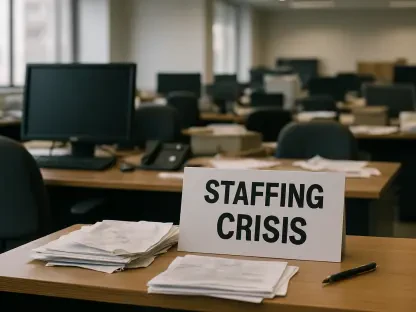The landscape of workplace equality enforcement is undergoing a seismic transformation, leaving employers grappling with uncertainty as they navigate a rapidly changing legal environment. With the U.S. Equal Employment Opportunity Commission (EEOC) charting a new course under the second Trump administration, businesses nationwide face a daunting challenge: adapting to sudden policy changes while maintaining compliance in a volatile regulatory landscape. Reports indicate a sharp pivot in enforcement priorities, raising questions about how these shifts will reshape antidiscrimination efforts. This roundup gathers insights from various legal experts and industry voices to explore the evolving role of the EEOC, highlighting diverse perspectives on enforcement strategies, diversity initiatives, and employer preparedness. The purpose is to provide a comprehensive view of these changes and actionable guidance for navigating uncharted regulatory waters.
Navigating Uncharted Waters: EEOC Under New Leadership
Shifting Enforcement Landscape
The EEOC’s direction under Chair Andrea Lucas has sparked significant debate among legal professionals, particularly following the longest federal shutdown and the current administration’s influence. Many industry observers note a marked departure from past strategies, with a focus now leaning heavily toward specific discrimination areas rather than broad systemic issues. This shift is seen as a direct reflection of executive orders that prioritize certain workplace concerns over others, creating a ripple effect across corporate policies.
Legal analysts highlight that the agency’s caseload appears to be realigning, with resources directed away from large-scale lawsuits that once dominated its docket. Some experts argue this could ease the burden on employers facing extensive investigations, while others caution that it merely redistributes legal risks to less predictable areas. The consensus is that businesses must stay alert to these evolving priorities to avoid unexpected compliance pitfalls.
Impact on Workplace Policies
Beyond enforcement, the broader impact on workplace culture and policy is a point of contention among professionals. Several attorneys emphasize that the EEOC’s current stance sends a strong signal to employers about reevaluating internal practices. This is especially critical at a time when legal challenges can emerge from multiple fronts, not just federal oversight.
A differing view suggests that while federal guidance may be narrowing in scope, state and local regulations often fill the gap, pushing companies to maintain robust inclusivity measures. This duality creates a complex environment where national policy shifts must be balanced against regional mandates, requiring a nuanced approach to policy development.
Decoding the EEOC’s Transformative Shifts
A Pivot in Enforcement Focus
One of the most discussed changes in the EEOC’s strategy is its move away from disparate-impact claims, traditionally a cornerstone of systemic discrimination cases. Legal voices point out that under the current leadership, the agency is instead prioritizing issues like religious and national origin discrimination. Data on agency dockets reveals a noticeable decline in large-scale systemic lawsuits, a trend that has caught the attention of many in the field.
This pivot has sparked a debate on its implications for employers. Some professionals believe the reduction in systemic cases could lighten the investigative load on businesses, allowing more focus on day-to-day operations. However, others warn that this redirection might simply shift legal exposure to other, less familiar areas of enforcement, necessitating a proactive stance to mitigate risks.
A third perspective underscores the unpredictability of this focus, suggesting that companies could face sudden scrutiny in areas previously considered low-priority. The lack of clear long-term guidance from the agency only heightens the need for continuous monitoring and adaptation of compliance strategies.
DEI Programs Under the Microscope
Diversity, equity, and inclusion (DEI) initiatives are facing intensified examination, with guidance from the EEOC leadership pointing to potential discrimination risks in these programs. Industry advisors stress the importance of restructuring such efforts to ensure they align with equal opportunity laws. Practical steps, like making mentorship and training accessible to all employees, are often cited as effective adjustments.
The political climate adds another layer of complexity, as companies must balance legal compliance with reputational concerns. Some legal experts note that while direct inquiries from the EEOC into DEI practices may have decreased, the underlying pressure remains, driven by broader administrative skepticism toward these initiatives. This creates a tightrope for businesses aiming to foster inclusivity without inviting scrutiny.
An alternative viewpoint focuses on the dual challenge of maintaining DEI goals amid shifting federal priorities. Advisors suggest that employers can mitigate risks by conducting thorough internal audits and ensuring programs are framed as universally beneficial, rather than targeting specific groups. This approach, they argue, helps navigate both legal and public perception challenges.
Stepping Back from Gender-Identity Protections
The EEOC’s retreat from gender-identity discrimination cases, influenced by executive orders emphasizing biological sex, has become a focal point of discussion. This policy shift intersects with an increased emphasis on religious objection cases, creating potential conflicts in workplace accommodations. Legal professionals note that this withdrawal marks a significant change from previous agency stances.
Regional differences play a crucial role in employer responses, as state and local laws often mandate continued inclusivity despite federal pullback. Some experts predict that advocacy groups will step into the gap left by the EEOC, driving private litigation that keeps pressure on businesses. This dynamic suggests that risks remain high, even without direct agency involvement.
A contrasting opinion warns against assuming reduced EEOC action equates to lower liability. The rise of individual lawsuits and class actions in this area is seen as a persistent threat, prompting calls for companies to maintain protective policies regardless of federal guidance. This underscores the need for a forward-thinking approach to employee rights and accommodations.
Operational Restart and Lingering Uncertainties
Post-shutdown, the EEOC’s recovery efforts reveal operational challenges, with delays in caseload management becoming a concern for many. Legal advisors point out that priority areas, such as religious discrimination, are likely to see faster processing, urging employers to prepare for resuming deadlines without delay. This restart phase adds another layer of uncertainty to an already fluid landscape.
Differing opinions emerge on the agency’s proactive reach, with some professionals arguing that its enforcement is often tied to individual charges rather than sweeping initiatives. This perspective suggests a limited scope for unprompted investigations, though it does not diminish the importance of readiness for potential cases. Businesses are advised to keep meticulous records and stay informed on case progress.
Another angle focuses on the broader impact of sudden policy reversals, which keep employers in a state of constant alertness. The unpredictability of these flips necessitates strategic foresight, balancing immediate compliance needs with long-term planning. This environment demands agility and a commitment to staying ahead of regulatory curves.
Key Insights and Employer Roadmaps
Legal experts collectively highlight several critical takeaways from the EEOC’s current trajectory, including its retreat from systemic and gender-identity cases alongside heightened DEI scrutiny. The unpredictability of enforcement priorities stands out as a unifying concern, with many urging businesses to adopt a proactive mindset. This involves regular policy audits to identify and address potential vulnerabilities before they escalate.
Actionable strategies include restructuring programs for inclusivity, ensuring they comply with equal opportunity principles while avoiding perceptions of bias. Advisors also recommend robust legal preparedness, such as engaging counsel to navigate emerging risks and staying updated on agency announcements. These steps are seen as essential for mitigating exposure in a shifting landscape.
Additionally, aligning workplace practices with both federal shifts and local mandates is a recurring piece of advice. Monitoring EEOC updates and participating in industry forums can provide early warnings of changes, enabling timely adjustments. This multi-faceted approach helps employers maintain compliance while fostering a resilient workplace culture.
The Path Ahead: Vigilance in a Fluid Landscape
Looking back, the discussions among legal experts painted a vivid picture of transformation and uncertainty at the EEOC, underscoring its profound impact on workplace civil rights enforcement. The diverse insights revealed a shared recognition of the challenges posed by shifting priorities and policy reversals. As the regulatory environment evolves, the emphasis on adaptability emerges as a cornerstone of effective response strategies.
Moving forward, employers are encouraged to deepen their engagement with legal resources and industry networks to stay abreast of developments. Exploring tailored compliance training for staff can further bolster readiness for unexpected shifts. By embedding flexibility into their operational frameworks, businesses can better position themselves to tackle future regulatory challenges and sustain equitable workplace environments.









